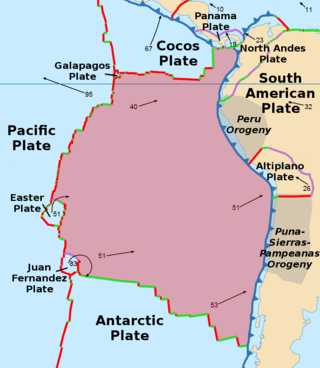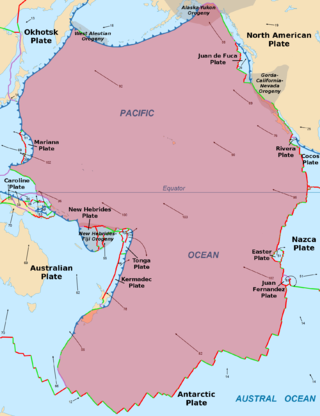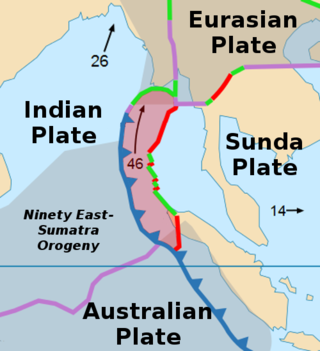
The North American plate is a tectonic plate containing most of North America, Cuba, the Bahamas, extreme northeastern Asia, and parts of Iceland and the Azores. With an area of 76 million km2 (29 million sq mi), it is the Earth's second largest tectonic plate, behind the Pacific plate.

The Nazca plate or Nasca plate, named after the Nazca region of southern Peru, is an oceanic tectonic plate in the eastern Pacific Ocean basin off the west coast of South America. The ongoing subduction, along the Peru–Chile Trench, of the Nazca plate under the South American plate is largely responsible for the Andean orogeny. The Nazca plate is bounded on the west by the Pacific plate and to the south by the Antarctic plate through the East Pacific Rise and the Chile Rise, respectively. The movement of the Nazca plate over several hotspots has created some volcanic islands as well as east–west running seamount chains that subduct under South America. Nazca is a relatively young plate in terms of the age of its rocks and its existence as an independent plate, having been formed from the breakup of the Farallon plate about 23 million years ago. The oldest rocks of the plate are about 50 million years old.

The Pacific plate is an oceanic tectonic plate that lies beneath the Pacific Ocean. At 103 million square kilometers, it is the largest tectonic plate.

The Explorer plate is an oceanic tectonic plate beneath the Pacific Ocean off the west coast of Vancouver Island, Canada, which is partially subducted under the North American plate. Along with the Juan de Fuca plate and Gorda plate, the Explorer plate is a remnant of the ancient Farallon plate, which has been subducted under the North American plate. The Explorer plate separated from the Juan de Fuca plate roughly 4 million years ago. In its smoother, southern half, the average depth of the Explorer plate is roughly 2,400 metres (7,900 ft) and rises up in its northern half to a highly variable basin between 1,400 metres (4,600 ft) and 2,200 metres (7,200 ft) in depth.

The Australian plate is a major tectonic plate in the eastern and, largely, southern hemispheres. Originally a part of the ancient continent of Gondwana, Australia remained connected to India and Antarctica until approximately 100 million years ago when India broke away and began moving north. Australia and Antarctica had begun rifting by 96 million years ago and completely separated a while after this, some believing as recently as 45 million years ago, but most accepting presently that this had occurred by 60 million years ago.

The Burma plate is a minor tectonic plate or microplate located in Southeast Asia, sometimes considered a part of the larger Eurasian plate. The Andaman Islands, Nicobar Islands, and northwestern Sumatra are located on the plate. This island arc separates the Andaman Sea from the main Indian Ocean to the west.

The Scotia plate is a minor tectonic plate on the edge of the South Atlantic and Southern oceans. Thought to have formed during the early Eocene with the opening of the Drake Passage that separates Antarctica and South America, it is a minor plate whose movement is largely controlled by the two major plates that surround it: the Antarctic plate and the South American plate. The Scotia plate takes its name from the steam yacht Scotia of the Scottish National Antarctic Expedition (1902–04), the expedition that made the first bathymetric study of the region.

A triple junction is the point where the boundaries of three tectonic plates meet. At the triple junction each of the three boundaries will be one of three types – a ridge (R), trench (T) or transform fault (F) – and triple junctions can be described according to the types of plate margin that meet at them. Of the ten possible types of triple junctions only a few are stable through time. The meeting of four or more plates is also theoretically possible, but junctions will only exist instantaneously.

The Phoenix plate was a tectonic plate that existed during the early Paleozoic through late Cenozoic time. It formed a triple junction with the Izanagi and Farallon plates in the Panthalassa Ocean as early as 410 million years ago, during which time the Phoenix plate was subducting under eastern Gondwana.

The South American–Antarctic Ridge or simply American-Antarctic Ridge is the tectonic spreading center between the South American plate and the Antarctic plate. It runs along the sea-floor from the Bouvet triple junction in the South Atlantic Ocean south-westward to a major transform fault boundary east of the South Sandwich Islands. Near the Bouvet triple junction the spreading half rate is 9 mm/a (0.35 in/year), which is slow, and the SAAR has the rough topography characteristic of slow-spreading ridges.

The 1,600 kilometres (990 mi) long Macquarie Fault Zone is a major right lateral-moving transform fault along the seafloor of the south Pacific Ocean which runs from New Zealand southwestward towards the Macquarie Triple Junction. It is also the tectonic plate boundary between the Australian plate to the northwest and the Pacific plate to the southeast. As such it is a region of high seismic activity and recorded the largest strike-slip event on record up to 23 May 1989, of at least 8.0
This is a list of articles related to plate tectonics and tectonic plates.
The Emerald Fracture Zone is an undersea fracture zone running the distance from the southwest corner of the Campbell Plateau to the northern tip of Iselin Bank. The name was proposed by Dr. Steven C. Cande of the Scripps Institution of Oceanography for the vessel Emerald, which traversed this region in 1821, and was approved by the Advisory Committee for Undersea Features in June 1997. The Emerald Basin to its north west was named from the same source. Some have restricted the name to the southern east west orientated transform fault zone but the north south orientated faults that define the eastern boundary of the Emerald Basin are generally included in the literature.

The Pacific Ocean evolved in the Mesozoic from the Panthalassic Ocean, which had formed when Rodinia rifted apart around 750 Ma. The first ocean floor which is part of the current Pacific plate began 160 Ma to the west of the central Pacific and subsequently developed into the largest oceanic plate on Earth.
The Hjort Trench is a linear topographic depression south of Macquarie Island in the southwest Pacific Ocean. Geologically, the depression is considered to be the seafloor expression of an ocean-ocean subduction zone, where the Australian plate is thrusting beneath the Pacific plate. As the southernmost portion of the Macquarie Ridge complex, the Hjort Trench lies in an area of diagonal convergence produced by the transform fault evolution of the Emerald Fracture Zone. Frequent seismic events, most less than 20 km (12 mi) deep, characterize the transpression along this plate boundary.

The Chile Ridge, also known as the Chile Rise, is a submarine oceanic ridge formed by the divergent plate boundary between the Nazca plate and the Antarctic plate. It extends from the triple junction of the Nazca, Pacific, and Antarctic plates to the Southern coast of Chile. The Chile Ridge is easy to recognize on the map, as the ridge is divided into several segmented fracture zones which are perpendicular to the ridge segments, showing an orthogonal shape toward the spreading direction. The total length of the ridge segments is about 550–600 km.
In the early morning hours of Friday 24 December 2004, a moment magnitude 8.1 earthquake struck a remote area of the southern Tasman Sea. Its epicentre was located roughly 360 km (224 mi) northwest of the Auckland Islands of New Zealand, and roughly 600 km (373 mi) north of Macquarie Island of Australia. Shaking was reportedly felt as far as Tasmania and the South Island. The event was a complex intraplate earthquake within the Australian plate, which generated a small tsunami.

The Hunter Fracture Zone is a sinistral (left-lateral) transform faulting fracture zone, that to its south is part of a triple junction with the New Hebrides Trench, and the North Fiji Basin Central Spreading Ridge. The Hunter Fracture Zone, with the Hunter Ridge, an area with recent volcanic activity to its north, is the southern boundary of the North Fiji Basin. This boundary area in the south-western part of the Hunter Fracture Zone is associated with hot subduction, and a unique range of volcanic geochemistry.

















